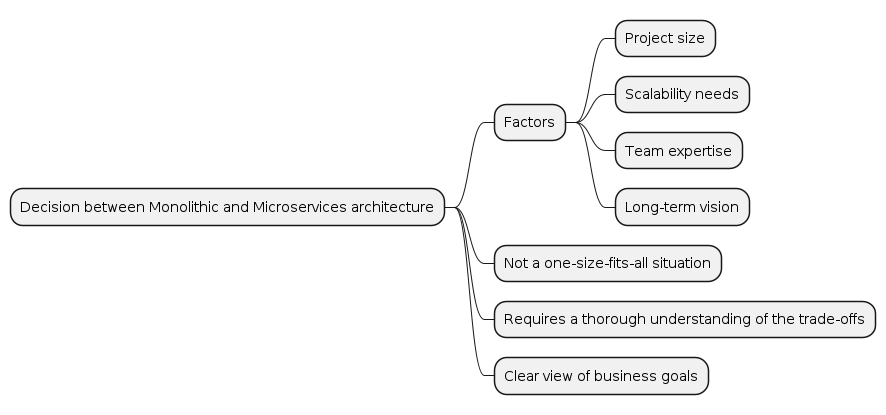In the vast universe of software development, the choice between Monolithic and Microservices architectures plays a pivotal role in the overall efficiency, flexibility, and scalability of your application. Whether you’re building a new application or re-engineering an existing one, understanding the benefits, disadvantages, and ideal use-cases of these architectures is crucial. In this blog post, we’ll delve into the nitty-gritty of Monolithic and Microservices architectures, their implications in MVP (Minimum Viable Product) development, the role of technologies like Docker and Kubernetes, and their potential influence on your marketing strategies.

Monolithic Architecture: An Overview
A monolithic architecture is a traditional unified model for the design of a software application. In this design, all the functional components (User Interface, server-side application logic, and the database layer) are tightly interconnected and unified into a single, autonomous unit.
Benefits of Monolithic Architecture
- Simplicity: Monoliths are straightforward to develop, test, and deploy as the application is treated as a single logical executable.
- Cross-cutting Concerns: Aspects such as performance monitoring, logging, caching, transaction management, etc., can be easily handled in a monolith.
- Consistency: All processes in a monolithic application share the same system resources, which can make data management more straightforward.
Drawbacks of Monolithic Architecture
- Scalability: Scaling specific functions of the application is challenging as the entire application needs to be scaled instead of individual components.
- Flexibility: Monoliths are not as flexible to technology changes and can be significantly affected by system failures.
- Development Speed: As the application grows, the complexity increases, slowing down the development process.
When to Use Monolithic Architecture
Monolithic architecture is best for small-scale applications where the application’s scope is well-defined and unlikely to change. It’s also suitable when a rapid prototyping approach or an MVP is needed for market validation.
Microservices Architecture: An Overview
Microservices architecture breaks down the application into small, loosely coupled, and independently deployable services. Each service represents a unique business capability and can be developed, deployed, and scaled independently.
Benefits of Microservices Architecture
- Scalability: Each microservice can be individually scaled as per demand.
- Technology Diversity: Different services can use different technologies, allowing teams to choose the best tool for each task.
- Fault Isolation: A failure in one service doesn’t affect the entire system.
Drawbacks of Microservices Architecture
- Complexity: Microservices introduce complexity in terms of inter-service communication, data consistency, and distributed system coordination.
- Data Management: Implementing transactions and ensuring consistency can be challenging in this decentralized model.
- Deployment and Management: Managing and orchestrating hundreds of services can be a daunting task.
When to Use Microservices Architecture
Microservices are ideal for large, complex applications that require high scalability and flexibility. They are also a good fit when you anticipate different services evolving at different paces or when you want to enable parallel development across multiple teams.
Microservices, Docker, and Kubernetes
Microservices often lean on containerization tools like Docker for packaging and deploying services. Docker containers encapsulate everything an application needs to run (code, runtime, libraries, system settings) into a standalone unit, ensuring that the application works uniformly across different computing environments.
When you have many containers, orchestration becomes a challenge. Kubernetes, a container orchestration platform, steps in here. It helps in automating deployment, scaling, and managing of containerized applications,
making it an excellent fit for microservices architecture.
Microservices Without the Cloud?
While microservices are often associated with cloud computing due to the elasticity and resource abstraction of the cloud, they certainly can run without it. Using on-premises servers or data centers can work, but it might require more initial infrastructure investment and ongoing management.
Monolith, Microservices, and MVP
When it comes to MVP development, both architectures can play a role. Monolithic architecture, with its simplicity, can help in faster initial market release. However, if you foresee your MVP evolving rapidly post-release, microservices can provide better scalability and flexibility.
Implications on Marketing
The choice between Monolith and Microservices might indirectly impact marketing. A well-implemented microservices architecture can ensure higher uptime, better performance, and rapid feature deployment, leading to enhanced user experience and satisfaction, thereby strengthening marketing efforts. Conversely, if implemented without due planning, microservices could lead to system instability, negatively affecting the brand image.
Conclusion
The decision between Monolithic and Microservices architecture depends on multiple factors, including project size, scalability needs, team expertise, and long-term vision. It’s not a one-size-fits-all situation. As with any architectural decision, it requires a thorough understanding of the trade-offs and a clear view of your business goals.








